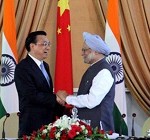Chinese Premier Li Keqiang has wrapped up his maiden visit to India – his first port of call after becoming Premier. Throughout the visit, he repeated his theme of ‘handshake across the Himalayas’ and maintained that “a few clouds in the sky cannot shut out the brilliant sunrays of our friendship.” It was a charm offensive, and mandarins on both sides wasted no time in declaring the visit successful. Diplomatic and media hoopla aside, what are the key takeaways from this visit for India?
On the border issue, Prime Minister Dr. Manmohan Singh publicly raised the topic of the recent Chinese incursion into Ladakh, but underplayed it by referring to it as merely an ‘incident’- perhaps in deference to the visiting dignitary or worse still, continuing his earlier rhetoric of it being a ‘localised problem.’ On his part, Premier Li chose not to mention it at all. However, during the closed door negotiations, the Chinese are reported to have flagged concerns on India’s infrastructure development activity in areas close to the Line of Actual Control (LAC) and proposed border defence cooperation agreement to keep the LAC peaceful. Meanwhile, the Special Representatives discussing the boundary issue are now meeting in June. The previous 15 rounds of negotiations between them have so far brought agreement on the parameters and guiding principles for resolving the dispute. While the Indian Government has prevaricated, the Chinese have consistently declined to exchange maps that define the LAC, which in effect gives them the opportunity to lay claims in all sectors.
India also raised the issue of China constructing dams on the Brahmaputra, insisting on a bilateral water-sharing treaty taking into consideration our position as a lower riparian country. This round went to China, which declined the suggestion for a treaty; just one Memorandum of Understanding (MoU) was signed, which merely upgraded the earlier MoUs on this issue that referred to the sharing of information on water flows in the monsoon to enable flood control.
On bilateral trade, India brought up the burgeoning trade deficit ($40.77 billion in 2012-13) and demanded greater access to Chinese markets. The Chinese Premier agreed to the point. But India must push China to give up protectionism and expeditiously address this problem before accelerating bilateral economic engagement to achieve the trade target of $100 billion by 2015. China is interested in signing a Regional Trading Arrangement (RTA) with India. But without first addressing the issues of taxation and manufacturing costs domestically, an RTA does not make sense for India – or else it becomes a target of Chinese dumping, like the U.S. and the E.U. which has recently threatened to file a trade dispute against the dumping of Chinese-made solar panels and telecom equipments in Europe.
On the diplomatic front, both the sides are taking a positive view and supporting each other’s friendship with other countries. Yet China is clearly concerned by New Delhi’s growing proximity to the U.S. in recent years. Li invoked a Chinese proverb to stress this when he stated that “No country can choose its neighbors, and a distant relative may not be as helpful as a near neighbor.” For China though, the distant relative, Pakistan, has proved useful in containing India by way of collusion on nuclear weapons and missiles- a collusion that India has watched over the years with growing disquiet.
Pertinently, after India, Li proceeded to Islamabad to meet the Pakistani leadership including the Prime Minister-in-waiting Nawaz Sharif – the first foreign dignitary to do so. Both the countries have signed various agreements including one on building an economic corridor and on a boundary management system between Xinjiang and Gilgit-Baltistan (which, along with Pakistan-occupied Kashmir, is claimed by India as part of Jammu and Kashmir).
In contrast with China’s energetic initiatives in upgrading and controlling various infrastructure projects in Pakistan (including the Gwadar port and the now-completed Karakoram highway), India’s attempts to expand its economic interests in the South Asian region appear feeble.
Significantly, the joint statement issued after the Singh-Li meeting did not carry the usual affirmation of the ‘One China’ principle, which recognises Tibet and Taiwan as Chinese territories. This is the second time the term has been absent, the first being in 2010 during then Premier Wen Jiabao’s visit. Additionally, the joint statement mentioned China’s support for India’s aspiration to play an enhanced role in the U.N. including in the Security Council which was reiterated by Li in his media statement. However, Beijing has remained non-committal on India’s candidature for a permanent seat.
Overall, the India-China relationship remains afflicted by a trust deficit and wide differences on key issues. While the leadership on both sides has sought to gloss over this, these divergences will only widen if both countries do not take steps to achieve substantial progress in the political, economic and security areas. A meaningful initiative from China in resolving the boundary dispute and addressing India’s concerns on the broadening trade gap, can act as a stimulant for creating that ‘strategic trust’ and ‘strategic consensus’ which Premier Li repeatedly talked about during his visit.
Sameer Patil is Associate Fellow, National Security, Ethnic Conflict and Terrorism, at Gateway House.
This article was exclusively written for Gateway House: Indian Council on Global Relations. You can read more exclusive content here.
For interview requests with the author, or for permission to republish, please contact outreach@gatewayhouse.in.
© Copyright 2013 Gateway House: Indian Council on Global Relations. All rights reserved. Any unauthorized copying or reproduction is strictly prohibited.


